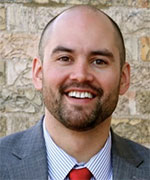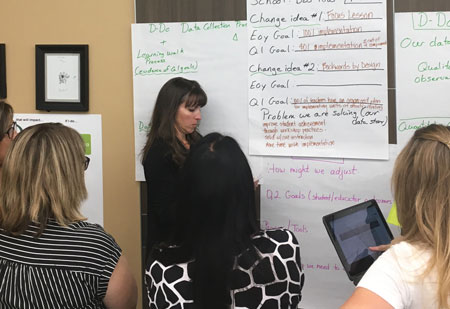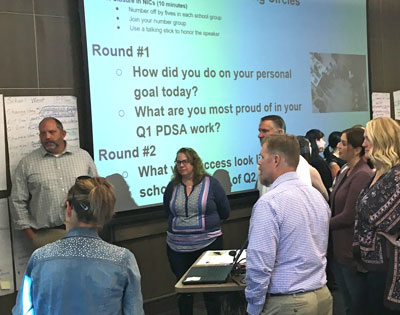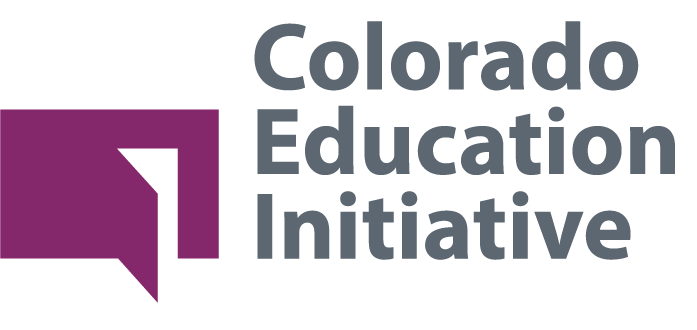Q & A: Danny Medved
October 25, 2019
Danny Medved is the Director of Professional Learning at Mesa County Valley School District 51 in Grand Junction. His desire to bring an all-encompassing district level of support for learner-centered school environments led him to the district three years ago.
Q. How did you get involved in education?
 I entered education as a second career after working in business and the outdoor rec industry. Over the course of 10 years, I worked in three different high school settings in Denver Public Schools. It was a passion of mine to support at-risk adolescents, so I started teaching in an alternative charter setting that was for adolescent young men. It was a competency-based environment; kids ranged in age from ages 13 to 20, and it was an opportunity for them to get social emotional support, a strong emphasis on exercise and good health, and accelerated credit recovery. From there I had the opportunity to be a part of leadership teams at other small, innovative high schools in DPS.
I entered education as a second career after working in business and the outdoor rec industry. Over the course of 10 years, I worked in three different high school settings in Denver Public Schools. It was a passion of mine to support at-risk adolescents, so I started teaching in an alternative charter setting that was for adolescent young men. It was a competency-based environment; kids ranged in age from ages 13 to 20, and it was an opportunity for them to get social emotional support, a strong emphasis on exercise and good health, and accelerated credit recovery. From there I had the opportunity to be a part of leadership teams at other small, innovative high schools in DPS.
Q. What brought you to the western slope and Mesa County Valley School District 51 (D51)?
Three years ago, some team members at D51 team introduced me to the possibility of moving to the western slope to advance professional learning and help move the D51 learning model forward. I was interested in the opportunity work with a strong team to scale competency-based practices. There were a lot of great structures already in place, such as the district’s teaching and learning framework, and a strong vision to support a learner-centered environment as a whole district. One of my big lessons learned being in innovative high schools was that district support matters. District support in DPS was what really helped us do good work at the high schools I was at before, and I saw an opportunity to be that support to the 43 schools in D51. It was also a good move for my family; we knew we needed to kind of slow things down; we have four kids, so it was also a decision to be able to put the emphasis on family for this next stage of life.
Q. What are some of the unique opportunities you have encountered in D51?
The big opportunity in D51 has been in developing interdependence and building strong leadership across teams. We had a reorganization about two years ago that created some challenges, but one of the big opportunities was that a number of departments that had been traditionally siloed were able to be organized with a common focus on our teaching and learning framework. For example, professional learning now has teacher induction, administrator induction, coaching, district inservices, and strategic compensation all under the umbrella of Professional Learning. These had all been separate departments prior, and so that’s been really powerful. Professional Learning now partners closely with our curriculum department, as we build a unified curriculum. We were able to pass our first bond/mill two years ago, the first time since 2004, and Professional Learning has been building out a runway that those resources can be folded into. That’s also been a huge opportunity.
Q. Do you collaborate with other districts on the western slope?
We have connected on some smaller projects, such as our Problem Based Learning; we also invited some western slope schools to a STEM summer institute that we held last summer.
A district that we’ve shared particular common focus with, has been Delta County School District, particularly with our emphasis on social emotional learning. Participation in CEI’s High School Redesign network has given us opportunities to share ideas, so there’s been good collaboration between our high schools, particularly around how to create student-centered culture supported by advisory programs. D51 and Delta schools have shared quite a few ideas.
In regard to size and scalability, our district has a lot in common with some of the schools districts on the front range. Greeley-Evans School District 6 and Thompson School District are very strong partners with us, and we’ve also partnered closely with St. Vrain Valley School District, particularly on our coaching program. Our coaching and professional learning coordinators have really learned a lot from St. Vrain, as well as our new teacher induction team–this team has advanced alignment by identifying a set of new teacher competencies and then linking those to video-enabled feedback cycles–that was something that we took away from our partnership with St. Vrain.
Q. Can you share some examples of how D51 has partnered with CEI, and what results you have seen?
CEI has helped us think about how to shift from design to implementation. We are participating in CEI’s Social Emotional Redesign Network, and that has helped us establish SEL as a district-wide priority.
D51, in a collaborative effort with teachers, the teachers’ association, really all departments, built some great tools, like our shared vision and our teaching and learning framework, and our partnership with CEI is advancing our practices to support our teaching and learning framework.
 I think the most recent, and most exciting story to tell, is the culmination of our efforts over the last five years in designing networked improvement communities (NICs) that are aligned to our teaching and learning framework. Each of our 43 schools is placed into one of seven NICs, and then each school identifies drivers and change ideas that they will implement and monitor through Plan-Do-Study-Act (PDSA) cycles. Schools monitor their identified change ideas through the use of a common PDSA monitoring tool and they collect evidence about the degree to which their change idea is taking place, how they were intentional in building value in that idea among their staff.
I think the most recent, and most exciting story to tell, is the culmination of our efforts over the last five years in designing networked improvement communities (NICs) that are aligned to our teaching and learning framework. Each of our 43 schools is placed into one of seven NICs, and then each school identifies drivers and change ideas that they will implement and monitor through Plan-Do-Study-Act (PDSA) cycles. Schools monitor their identified change ideas through the use of a common PDSA monitoring tool and they collect evidence about the degree to which their change idea is taking place, how they were intentional in building value in that idea among their staff.
 Over the course of the school year, the school leadership teams come together for four different NIC convenings with district instructional coaches. They assess themselves, do the study, and then plan for adjustments, and push each other as critical friends within their networks. Additionally, area directors, who hold principals accountable and provide coaching, sit side-by-side with school leadership teams and coach schools like they never have before. They have a very clear picture of each school’s focus, so they’re giving feedback and looking for school progress based on that focus. This has taken us from a loose implementation to a much more laser-focused implementation that’s growth-oriented and teacher-led at each site.
Over the course of the school year, the school leadership teams come together for four different NIC convenings with district instructional coaches. They assess themselves, do the study, and then plan for adjustments, and push each other as critical friends within their networks. Additionally, area directors, who hold principals accountable and provide coaching, sit side-by-side with school leadership teams and coach schools like they never have before. They have a very clear picture of each school’s focus, so they’re giving feedback and looking for school progress based on that focus. This has taken us from a loose implementation to a much more laser-focused implementation that’s growth-oriented and teacher-led at each site.
Over the course of the school year, the school leadership teams come together for four different NIC convenings with district instructional coaches. They assess themselves, do the study, and then plan for adjustments, and push each other as critical friends within their networks. Additionally, area directors, who hold principals accountable and provide coaching, sit side-by-side with school leadership teams and coach schools like they never have before. They have a very clear picture of each school’s focus, so they’re giving feedback and looking for school progress based on that focus. This has taken us from a loose implementation to a much more laser-focused implementation that’s growth-oriented and teacher-led at each site.
These teams have really made the PDSA model a part of how they do business. We’re starting to see it build momentum and focus for our district. It’s been cool because we’ve been able to really empower the schools to hold themselves accountable and to champion work that’s relevant to their context. This shared leadership gives teachers and instructional coaches an elevated voice, so it’s not a top-down initiative now.
Q. What big projects are you working on now?
I think this year is really about building our system’s capacity to engage in continuous improvement via NICs and the PDSA model. The other big project is our work to strengthen our focus on student services, and addressing equity concerns in the area of special education, students of color, and our free and reduced and ELL populations, keeping an emphasis on student outcomes and achievement. We measure our success by both academic and SEL outcomes and that’s where we need to focus. We’ve been building capacity in those areas, and we’re trying to ensure that our unified curriculum, particularly our assessment framework, is in service of supporting student outcomes as its measure of success.
Q. Looking into the future, what are your aspirations for D51 in the next five years?
 Closing achievement gaps and creating equitable opportunities, particularly for our more disadvantaged populations; all of our work is in service of that goal; and I think that’s getting more clear to all stakeholders and departments. A plan is only as good as your ability to measure it, and we’re at this great place where that’s being viewed as a growth opportunity and not a top-down accountability initiative. It’s measurement, and continuous improvement, and addressing our gap areas for our kids who are not succeeding right now.
Closing achievement gaps and creating equitable opportunities, particularly for our more disadvantaged populations; all of our work is in service of that goal; and I think that’s getting more clear to all stakeholders and departments. A plan is only as good as your ability to measure it, and we’re at this great place where that’s being viewed as a growth opportunity and not a top-down accountability initiative. It’s measurement, and continuous improvement, and addressing our gap areas for our kids who are not succeeding right now.
Mesa County Valley School District 51 is located in Grand Junction, on Colorado’s western slope. The district serves 22,000 students.


